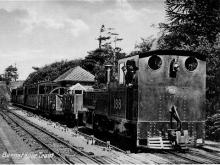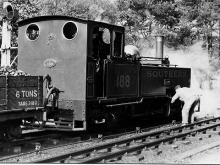The mystery of Lew
O mistério de Lew
Do you know the whereabouts or the fate of this steam loco?...
LEW was manufactured by Manning Wardle & Co. in 1925 and was used by the Southern Railway in England on its 2' (60cm) gauge branch line running between Barnstaple & Lynton. The line closed in 1935 and this particular locomotive was the only loco not scrapped.
After being used to dismantle to railway it was sold for use in Brazil - the letters "A.L.C." and "Pernambuco" were painted on the front of it's side tanks when in 1936 it was being loaded for shipment to Wales . At Swansea Docks the loco was loaded aboard the S.S. Sabor destined for the port of Recife in Brazil.
It has not been possible to find any record of the loco being unloaded, and as most of the relevant shipping records were destroyed in World War II we have no way of discovering its eventual destination.
The loco's ultimate destination in Brazil and its subsequent history remains a mystery to this day. Even if scrapped, it would be nice to find what eventually happened. Did this one surviving locomotive of the Lynton & Barnstaple Railway live on to work abroad for a few years before suffering the fate of her sisters?
Eddie Edmundson wrote the following back in 1998
Here is my own contribution to the Search for Lew saga. In 1994 the British Embassy in Brasilia forwarded to me a letter from the Lynton & Barnstaple Railway Association asking whether anyone could follow up some clues as to the whereabouts of Lew, since there was quite strong evidence that this locomotive was despatched to a sugar mill in north east Brazil. I imagine that it is well known that this Manning Wardle 2-6-2T was shipped from Swansea on 29 September 1936 aboard the SS Sabor and that its destination was Pernambuco (now called Recife - where I live). The only other fact known about this despatch is that she carried a shipping mark "ALC" painted upon her sides. You will also know that the Association sent a member called Patrick Lloyd on two trips to Brazil, in 1989 and 1991. Unfortunately it has proved difficult to get in contact with Patrick in order to learn what he had discovered in Brazil.
However, it was possible to glean that there was a sugar mill called Usina São José in the State of Alagoas (just to the south of my State of Perbambuco) and that this mill was owned by Abilio Leão da Cunha, which might well account for the letters ALC painted on the side of the loco. Patrick Lloyd claimed to have visited this Usina, and to have found the remains of an engine shed and a short length of 600 mm railway track. He is also reported to have stated that LEW was at this mill for a short period in 1939, but was sold again, and eventually ended up at a wood mill in Argentina, where she may still exist.
The Usina in Alagoas was said to be near the town of Atalaia. So I decided to investigate. I spent a morning at the public archive in Maceió (the port and capital of Alagoas State) and spoke extensively with the Director of the Archive (Noacir Medeiros de Santana) who is probably the foremost authority on the history of Usinas in the State - in fact I have his book on this history. And in the afternoon I drove out into the interior of the State to follow up the leads. This is what I discovered:
i) There certainly was an Usina called São José near Maceió. Noacir's book describes it as an 'engenho' - smaller than an Usina. Noacir expressed surprise that such a small undertaking could afford (or need) a steam locomotive. He kindly offered to check his records at home, and later telephoned me to say that the São José had started up with the harvest of 1935/36, and that its last harvest was in 1940/41. He also recalled the name of Abilio Leaõ da Cunha as certainly someone connected with the Usina sugar business, although he was unsure whether he was associated with the São José engenho. Incidentally, the full name of the engenho was probably São José da Lagoa.
ii) Noacir also told me that on closing down the São José bacame part of the Usina Ouricuri. It is pertinent to note, I think, that without this detail it would have been virtually impossible to find any relevant usina near Atalaia. Some old timers paying dominoes in public squares in the twons I passed through remembered the São José.
iii) I visited the Ouricuri Usina - it is in fact not near Atalaia, but 15 km from Branca de Atalaia (another town) which is in turn 55 km by road from Maceió. Sadly the Usina closed down in 1992, but it must have been working when Patrick Lloyd came over to Brazil, and I can only assume that he must have visted this Usina. I was not allowed into the Usina, but I did meet an engineer who had worked for 12 years at this Usina, and he assured me that he had never seen any vestige of railway operation nor heard any discussion of railway transport.
Well, I haven't taken the search much further, but I thought this might be of interest since, indeed, it is just possible that LEW did work on a sugar mill in north east Brazil.
By the way, I have seen two Manning wardles, both in the south of Brazil, but the wheel configurations are different.
Eddie Edmundson
Dave Tooke wrote article on the shipment of LEW to Brazil which was published in Industrial Railway Record 204 March 2011. CLICK HERE TO READ IT
Although the L&B Trust is neither actively pursuing, supporting or encouraging anyone to enter projects intended to locate or even recover any remains of Lew, it is interested in knowing more of the loco's ultimate fate. If, through your own researches, you can shed some light on the existence or fate of Lew or have any other information about what happened to this locomotive, please let us know...
New-build Lynton & Barnstaple Railway loco 190 "Lyd" at Woody Bay 18th May 2013. (Photo: Barney Staples)
Sabe a moradia ou o destino deste trem de vapor?...
O Lew foi fabricado por Manning Wardle & Co. Em 1925 e foi usado pela Ferrovia do Sul em Inglaterra em seus 2' (60cm) via férrea correndo entre Barnstaple & Lynton. A linha fechou em 1935 e esta locomotiva foi vendida em um leilão em 1936.
Acreditamos que esta locomotiva foi vendido para alguém em Brasil – as letras "A.L.C” e "Pernambuco" foram pintados na frente deste locomotiva é no tanques dos lados na última fotografia que foi tirado em Barnstaple em 1936 quando estava sendo carregado para remessa. A locomotiva foi carregada a bordo do S.S Sabor e foi presumido ter sido descarregado no porto de Recife em Brasil.
Não foi possível achar qualquer registro desta locomotiva sendo descarregado, a maioria dos registros relevantes de despacho foram destruídos na Segunda Guerra Mundial. Parece que não temos nenhum jeito de descobrir seu destino final.
A Ferrovia de Lynton & Barnstaple está completamente focalizada no projeto de reconstruir a ferrovia em Devon. Tem 71 anos agora desde que esse locomotiva partiu do Reino Unido, nós não podemos justificar o esforço e despesa em tentar de procurar o louco.
O destino do Lew, e o que aconteceu permanece um mistério até hoje. Seria amável achar o que eventualmente aconteçeu. E o caso que esta unica locomotiva da ferrovia de Lynton & Barnstaple esta presentemente intacto? Talves trabalhou ne um país estrangeiro para alguns anos antes de sofrer o destino de suas irmãs?
Se pode derramar alguma luz na existencia ou destino de Lew, ou tem qualquer outra informação sobre oque aconteçeu com esta locomotiva, deixa-nos saber...


























